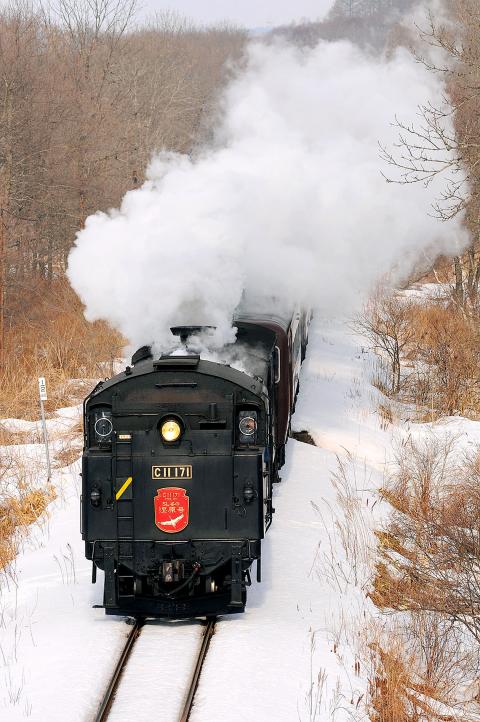Taiwan and Japan plan to launch a joint rail tourism campaign next month as part of expanding links between the two countries since a massive earthquake struck Japan in March last year.
In the campaign, dubbed “sister trains,” Taiwan’s CK124 steam engine and a similar Japanese train called the Hokkaido SL Fuyu-no-Shitsugen will be used to promote railway travel in both countries, authorities said.
The partnership idea came about during a visit to Taiwan by Japanese officials in April last year to promote tourism as part of Japan’s disaster recovery efforts.

Photo: CNA, courtesy of the Taiwan Railways Administration
After months of discussions and with the help of non-profit organizations, a promotional campaign was devised featuring a plan called “Train Travel: Winter in Hokkaido and summer in Taiwan.”
It is to be formalized on March 12 in a letter of intent signed by the Japan Hokkaido Railway Co (JR Hokkaido) and the Taiwan Railways Administration (TRA).
“It is the first time that Taiwan has entered into such a partnership with a foreign rail company,” said Wang Chuan-hsin (王川信), the TRA division chief in charge of the project.
JR Hokkaido said the promotional campaign is expected to help revive the economy in northeast Japan, an area that was hit hard by the powerful earthquake and ensuing tsunami on March 11 last year.
The partnership is also a means to express Japan’s gratitude for Taiwan’s tremendous humanitarian aid in the wake of the disaster, JR Hokkaido said.
For Taiwan, the project also offers an opportunity to enhance cultural preservation, according to the Society of Railway and National Planning, which has been involved in the partnership.
“We hope Taiwan can take this opportunity to learn from Japan’s ways of preserving invaluable cultural heritage like these locomotives,” said Jen Hen-yi, a spokesman for the society.
Although the full details of the promotional campaign have not been finalized, the TRA said, it plans to invite its Japanese counterpart to take part in Taiwan’s Railway Festival in June.
The CK124, built in 1936, is one of Taiwan’s most popular steam locomotives and is widely used by the TRA for promotional purposes.
In Japan, the C11-171 engine that pulls the SL Fuyu-no--Shitsugen Train was manufactured in 1940 and operated in various parts of Hokkaido.

Trips for more than 100,000 international and domestic air travelers could be disrupted as China launches a military exercise around Taiwan today, Taiwan’s Civil Aviation Administration (CAA) said yesterday. The exercise could affect nearly 900 flights scheduled to enter the Taipei Flight Information Region (FIR) during the exercise window, it added. A notice issued by the Chinese Civil Aviation Administration showed there would be seven temporary zones around the Taiwan Strait which would be used for live-fire exercises, lasting from 8am to 6pm today. All aircraft are prohibited from entering during exercise, it says. Taipei FIR has 14 international air routes and

The Ministry of National Defense (MND) today released images of the military tracking China’s People's Liberation Army (PLA) movements during the latest round of Chinese drills around Taiwan. The PLA began "Justice Mission 2025" drills today, carrying out live-fire drills, simulated strikes on land and maritime targets, and exercises to blockade the nation's main ports. The exercises are to continue tomorrow, with the PLA announcing sea and air space restrictions for five zones around Taiwan for 10 hours starting from 8:30am. The ministry today released images showing a Chinese J-16 fighter jet tracked by a F-16V Block 20 jet and the

Snow fell on Yushan (Jade Mountain, 玉山) yesterday morning as a continental cold air mass sent temperatures below freezing on Taiwan’s tallest peak, the Central Weather Administration (CWA) said. Snowflakes were seen on Yushan’s north peak from 6:28am to 6:38am, but they did not fully cover the ground and no accumulation was recorded, the CWA said. As of 7:42am, the lowest temperature recorded across Taiwan was minus-5.5°C at Yushan’s Fengkou observatory and minus-4.7°C at the Yushan observatory, CWA data showed. On Hehuanshan (合歡山) in Nantou County, a low of 1.3°C was recorded at 6:39pm, when ice pellets fell at Songsyue Lodge (松雪樓), a

City buses in Taipei and New Taipei City, as well as the Taipei MRT, would on Saturday begin accepting QR code payments from five electronic payment providers, the Taipei Department of Transportation said yesterday. The new option would allow passengers to use the “transportation QR code” feature from EasyWallet, iPass Money, iCash Pay, Jkopay or PXPay Plus. Passengers should open their preferred electronic payment app, select the “transportation code” — not the regular payment code — unlock it, and scan the code at ticket readers or gates, General Planning Division Director-General Liu Kuo-chu (劉國著) said. People should move through the